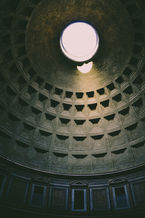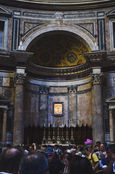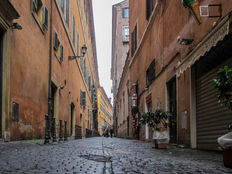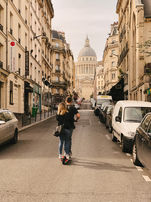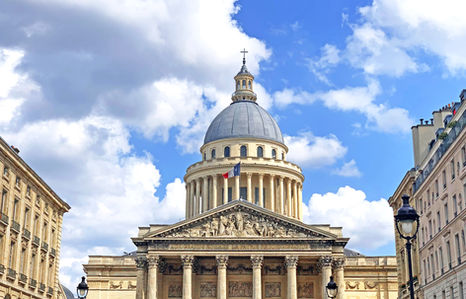
The Latin quarter
The Latin Quarter is a district of Paris that is known for its history rich in art and culture. Since the Middle Ages, this district has become a center of learning and creation for artists, writers, philosophers and intellectuals.
In the 19th century, the Latin Quarter became the home of many artistic movements such as Romanticism and Realism. Cafes, theaters and art galleries flourished in the area, attracting crowds of creatives and art lovers.
His history...
The Latin Quarter is also known as “La Montagne Sainte-Geneviève”. This name is derived from the fact that the hill of Sainte-Geneviève, where the Sorbonne and the Saint-Étienne-du-Mont church are located, is located in the district. The name "Quartier Latin" comes from the fact that Latin was the language of instruction in the region's schools from the Middle Ages until the French Revolution.
At the beginning of the 20th century, the Latin Quarter was the cradle of the Art Nouveau movement, with the architect Hector Guimard as one of its main representatives. The movement focused on organic and natural beauty, and influenced art and architecture around the world.
Later, the Latin Quarter became an important center for modern artists, notably the Cubist movement with artists such as Pablo Picasso and Georges Braque.
Artistic inspirations...
The Latin Quarter of Paris has been the birthplace of several important artistic movements throughout history, including:
-
The Art Nouveau Movement – which emerged in the 1890s and was known for its floral aesthetic and organic forms. Artists like Hector Guimard and Émile Gallé created buildings and art objects in this style.
-
The Cubist Movement – which emerged in the 1900s and was known for its fragmentation of form and space. Artists like Pablo Picasso, Georges Braque, and Juan Gris created works of art that influenced art movements to come.
-
The Surrealist Movement - which emerged in the 1920s and was known for its exploration of the unconscious and dreams. Artists like Salvador Dali, Max Ernst, and René Magritte created works that sought to transcend the limits of reality.
-
The Existentialist Movement – which emerged in the 1940s and was known for its exploration of human existence and the human condition. Writers and philosophers like Jean-Paul Sartre and Albert Camus created works that influenced the culture and thinking of the time.
-
The May 68 Movement – which emerged in the 1960s and was known for its protest against the political and social status quo of the time. Students and workers took part in protests and strikes to demand political and social reforms. It also had an impact on the culture and art of the time.
The most fascinating streets of the LATIN QUARTER
It's good to stroll through the streets of this district full of character and history.
Start from Rue Mouffetard, one of the oldest and most famous in the Latin Quarter. It is known for its lively atmosphere and open-air food market, with many stalls selling fruit, vegetables, cheeses, meats and fish. You can also find many restaurants, cafes and bars there.
Also get lost in the picturesque Rue Galande, lined with medieval houses and antique shops. There are several independent bookstores, as well as the La Clef cinema.
At Rue de la Huchette! This narrow, cobbled street is known for its many restaurants, cafes and bars, as well as its souvenir and vinyl record shops. Walk to Place Saint-Michel, which offers breathtaking views of the Seine and Notre-Dame.
Don't forget Rue Saint-Séverin, it is one of the oldest in the Latin Quarter, with half-timbered houses and medieval buildings and rich in churches, including the Saint-Séverin church.
End the evening on Rue des Canettes, where the many lively bars and cafés will delight night owls. Note nearby the Saint-Sulpice church and its famous organs.














An idea of the LATIN QUARTER THROUGH LITERATURE
-
"The Belly of Paris" by Émile Zola: "It was a corner of the city cluttered with old crooked streets, a network of dark and narrow alleys, a sort of labyrinth intertwined with beams, gables, roofs that touch each other , clerestory windows, tangled interior courtyards, secret passages."
-
"Notre-Dame de Paris" by Victor Hugo: "The City and the University extended their winding streets around Notre-Dame; one ended at the Saint-Michel bridge and the flower market, the other at the Hôtel de Cluny and the Collège de Sorbonne. This whole district, so populous during the day, was deserted at night; the streets dark, the squares deaf."
-
“Paris is a Party” by Ernest Hemingway: “The Latin Quarter was always beautiful in the morning, the Luxembourg Gardens were clean, the white statues were clean, the people were polite in the shops and in the bistros in the morning.”
-
“Les Mots” by Jean-Paul Sartre: “The Latin Quarter was full of brasseries, cafes and bookstores. Students occupied it, they debated passionately and made half-hearted revolutions. Philosophers quarreled there and rebuilt the world."
-
“La Nausée” by Jean-Paul Sartre: “I passed in front of the Sorbonne, rue Saint-Jacques, the Panthéon. It all had an air of celebration. Girls were laughing, students were singing as they walked, couples were kissing. The Latin Quarter was happy that evening."
If we had to name a few must-see places in this neighborhood...
-
The Sorbonne: founded in 1253, the Sorbonne is one of the oldest universities in the world. It was founded by Robert de Sorbon, confessor of Louis IX, to train theologians and clerics. The Sorbonne played an important role in the history of France, particularly during the revolutions of 1789 and 1968. Today, it is one of the most renowned research and teaching centers in the world.
-
The Pantheon: built at the end of the 18th century, the Pantheon is a neoclassical monument which honors the great figures of French history. It was originally built as a church dedicated to Sainte-Geneviève, the patroness of Paris. After the French Revolution, it was transformed into a secular monument. Today, the Pantheon houses the tombs of famous figures like Voltaire, Rousseau, Victor Hugo, Émile Zola, Marie Curie, Alexandre Dumas and others.
-
The Saint-Michel fountain: located on the Place Saint-Michel, the Saint-Michel fountain is a monumental fountain representing the archangel Saint-Michel slaying the dragon. It was built in the 19th century to replace an old 17th century fountain which had been demolished.
-
The Saint-Séverin church: built in the 13th century, the Saint-Séverin church is a remarkable example of French Gothic architecture. It is located near the Seine, in a picturesque street in the Latin Quarter. The church is famous for its magnificent stained glass windows, sculptures and frescoes.
-
The Jardin des Plantes: created in the 17th century, the Jardin des Plantes is a world-renowned botanical garden. It is home to many rare and exotic plant species, as well as several museums and a menagerie. The garden is open to the public and is a beautiful walk for nature lovers and the curious.
-
Rue Mouffetard: a cobbled pedestrian street lined with restaurants, shops and cafes, which dates from the Middle Ages. It's one of the busiest and most picturesque streets in the Latin Quarter, and it attracts tourists and locals alike.
-
The Collège de France: founded in the 16th century, the Collège de France is a renowned higher education establishment, renowned for its conferences and public courses. It was created to provide free and open education to all, without any preconditions. Today, the Collège de France is one of the most important research centers in France, with internationally renowned teachers and researchers.
Image Gallery





